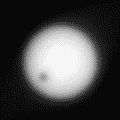
|

|
Background
There is alot of Martian imagery out there but nothing quite like the LPL at UofA. These operators of the HiRISE project are on the cutting edge with their 25cm / pixel resolution & their meaningful colour processing. Their website is solid, with search criteria capable of listing their catalogue by time or coordinates (among other things). Their RGB images however are maintained as enormous sampling swaths often in excess of 3M. The thumbnails on their selection page (~50K) & on their detail page (~200K) consist of a small rectangle normally at the midpoint of the image. There is no way to get an idea of the full contents of a pic without downloading it completely. Even without loading the panes of their invaluable google-derived MOLA context map the process of examining a single image can be discouragingly resource intensive.
Over in THEMIS land at ASU the MSFF folks have created an integrated service which attempts to provide access to the various Martian image catalogues (Viking, MGS, HRSC, &c.). Its tempting to try to use this "Mars Image Explorer" as a window into their snapshot of the HiRISE data, as its capable of serving a preview of an entire swath comparable in size to the HiRISE excerpt thumbnail. Unfortunately the ASU system scripts hang browser sessions in a short time if they work at all, & their summary listings of the coordinate data are less than complete. In fact, it becomes clear that the entire application structure on themis-data.asu.edu can be bypassed, as all it ultimately does is format an enormous URL it hands to the image.mars.asu.edu server. In brief, this URL contains the HiRISE ID repeated 2x & a specification for the orbit number range which can be readily computed anyway. A simple kludge effected via an HTML form & some javascript can prove to be reasonably expeditious.
How Does It Work?
With the MarsLonga form displayed & cleared bring up the HiRISE site in its own tab & use their search function to build their typical query page, with up to 16 thumbnails on it. Simply rightclick on an image of interest & copy the link / location address of its target detail page. Now paste the copied address into the form & hit "Submit" which will display a screen with a clickable (& tabbable) link referencing the ASU preview which you can select. Thats it! The link comes up in its own tab as certain browsers dont return well from this technique (& IE6 doesnt seem to support it at all). The JPG preview can then be magnified by the browser to survey the contents of the entire image. If it seems like something worth pursuing, return to the HiRISE site, & bring up the detail screen & fullsize image as normal.
A Word About the ASU Previews
When ultra high resolution is not an issue the ASU preview images are often viable alternatives to the fullsize HiRISE pix. Theyre smaller in size, not reprojected, oriented properly (north is up), & colourised in a slightly different (normally darker) way from their HiRISE counterparts. On the other hand a number of them are partially masked by a translucent colour band which decreases their aesthetics. Note that saving an ASU image directly from the browser is generally thwarted by the way its served & it often must be pulled explicitly from the browser cache. This, the way it often restarts partway thru the send, & the occasional 500 internal server error help explain some (but not all) of the haplessness of the MIE application. In fact, when requesting previews this way I seem to experience missing images less often than when trying to use MIE as the frontend.
Conclusion
As you can see I know just enough HTML & javascript to keep from writing too much of it, & lets face it: this isnt rocket science. Although this simple hack works as described as of this writing, it is of course illadvised to dig thru the software engineering of others as it is subject to change without notice. Nonetheless this function makes it possible & convenient to use the best of both facilities to make up for the deficiencies in each. The HiRISE images of Mars are one of the supreme achievements of mankind & should be avidly studied by anyone with access to a computer.
 last update: 2009oct16
last update: 2009oct16
|

|